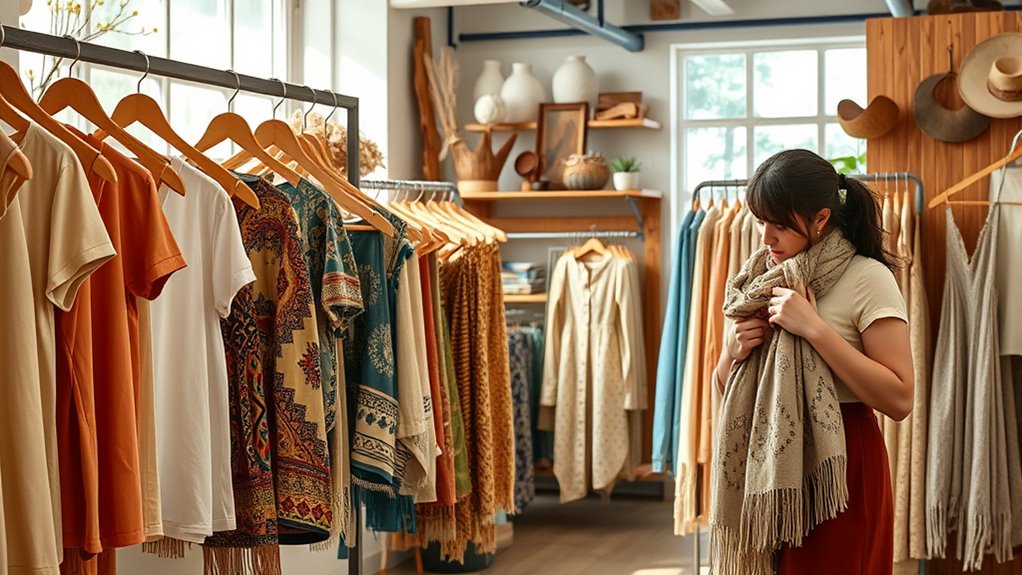To shop sustainably and save the planet, focus on eco-friendly fabrics like organic cotton, hemp, or recycled materials, and choose brands with clear ethical practices and certifications. Buying secondhand or vintage pieces extends garment life and reduces waste. Support local or small-scale brands committed to sustainability. By making these smart choices, you’ll help minimize pollution and conserve resources. Keep exploring these secrets to make even more impactful shopping decisions.
Key Takeaways
- Prioritize brands with eco-friendly fabrics like organic cotton, hemp, and recycled materials to reduce environmental impact.
- Choose secondhand or vintage clothing to extend garment life and minimize textile waste.
- Look for certifications such as GOTS, Fair Trade, and B Corp to ensure ethical and sustainable practices.
- Support small or local brands that emphasize transparent supply chains and fair labor conditions.
- Invest in high-quality, durable pieces to avoid fast fashion waste and save money long-term.

Have you ever wondered how to look stylish while minimizing your environmental impact? The good news is, you can achieve a trendy wardrobe that’s also eco-conscious by understanding some key principles of sustainable fashion. One essential aspect is choosing clothing made from eco friendly fabrics. These fabrics, like organic cotton, hemp, Tencel, and recycled materials, are produced with less water, fewer chemicals, and a smaller carbon footprint compared to conventional textiles. When you prioritize fabrics that are sustainable, you help reduce pollution and conserve resources, making your fashion choices more responsible.
Choose eco friendly fabrics like organic cotton, hemp, and Tencel to create a stylish, sustainable wardrobe.
But it’s not just about the materials; ethical manufacturing plays a vital role too. When shopping, seek out brands that prioritize fair labor practices, safe working conditions, and transparent supply chains. Ethical manufacturing ensures that the people who make your clothes aren’t exploited and that environmental standards are upheld throughout production. By supporting such brands, you’re helping to promote a fairer industry and encouraging companies to adopt more sustainable practices. This combination of eco friendly fabrics and ethical manufacturing means you’re not only dressing well but also aligning your choices with your values.
To shop smart, look for certifications like GOTS (Global Organic Textile Standard), Fair Trade, or B Corp, which verify a brand’s commitment to sustainability and fair labor. These certifications can guide you toward authentic eco-friendly and ethically produced clothing. Also, consider investing in quality pieces that will last longer, rather than buying cheap fast fashion that wears out quickly. This reduces waste and the need for constant repurchasing, ultimately saving you money in the long run.
Another tip is to support local or small-scale brands that prioritize sustainable practices. They often use eco friendly fabrics and maintain ethical manufacturing standards, making it easier for you to make responsible choices. Additionally, buying secondhand or vintage clothing extends the life of garments and prevents textiles from ending up in landfills. Incorporating sustainable fabrics into your wardrobe not only benefits the environment but also encourages innovation and growth within the eco fashion industry.
Frequently Asked Questions
How Can I Identify Truly Sustainable Clothing Brands?
To identify truly sustainable clothing brands, look for eco label certifications like Fair Trade or GOTS, which guarantee eco-friendly practices. You should also check if they have transparent supply chains, so you know where and how their clothes are made. Brands committed to sustainability often share detailed info about their sourcing, manufacturing, and environmental impact. This transparency helps you shop smarter and supports truly eco-conscious brands.
What Are the Best Ways to Care for Eco-Friendly Garments?
Think of your eco-friendly garments as delicate flowers that need gentle care. When garment washing, use cold water and eco-conscious detergents to preserve their beauty. For stubborn stains, opt for natural stain removal methods like baking soda or vinegar. Avoid over-washing to prevent wear. Treat your clothes with care, and they’ll stay vibrant longer, helping you reduce waste and protect the planet. Your mindful care makes a real difference.
Are Second-Hand Clothes Always More Sustainable Than New?
You might wonder if second-hand clothes are always more sustainable than new ones. While they often extend the clothing lifespan and have a higher resale value, this isn’t always the case. Factors like how often the item was worn or its condition matter. Buying second-hand can be greener, but consider the item’s journey and how it fits into sustainable fashion practices to make the best choice.
How Does Sustainable Fashion Impact Local Communities?
You might think fashion is just about looking good, but sustainable choices influence communities too. When you support brands committed to ethical sourcing, you’re empowering local workers and fostering fair wages. This creates a ripple effect, strengthening community resilience. By choosing sustainable fashion, you help promote community empowerment and ensure that production benefits those who craft your clothes, transforming your wardrobe into a tool for positive social change.
Can Fast Fashion Ever Be Environmentally Responsible?
Fast fashion often seems incompatible with environmental responsibility due to its rapid production and waste. However, it can become more responsible if brands adopt sustainable practices like using eco-friendly materials and reducing waste. You can also support brands committed to transparency and ethical labor. While completely eco-friendly fast fashion is challenging, choosing wisely and pushing companies toward greener methods helps balance affordability with environmental responsibility.
Conclusion
By choosing sustainable fashion, you’re turning the tide in the fight for our planet. Every small decision, like opting for eco-friendly brands or caring for your clothes, is like planting a seed for a greener future. Remember, you hold the power to make a difference—each mindful purchase is a step toward a more beautiful, sustainable world. So, shop smart, stay conscious, and let your style be a beacon of hope in a sea of change.








